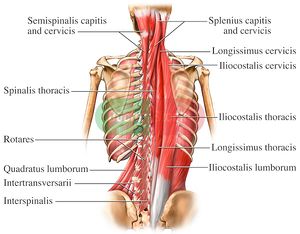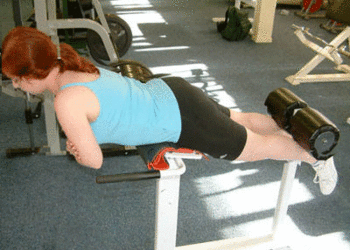Manual Muscle Testing: Trunk Extension: Difference between revisions
No edit summary |
No edit summary |
||
| (12 intermediate revisions by 2 users not shown) | |||
| Line 3: | Line 3: | ||
"'Top contributors"'-{{Special: Contributors/{{FULLPAGENAME}}}} | "'Top contributors"'-{{Special: Contributors/{{FULLPAGENAME}}}} | ||
</div> | </div> | ||
==Introduction== | |||
[[File:Semispinalis c.jpg|thumb|Deep back muscles]] | |||
Low levels of [[Endurance Exercise|endurance]] of [[Back Muscles|back muscles]] are reported as cause and effect of [[Low Back Pain|low back pain]]. [[Muscle Strength Testing|Muscle strength testing]] is a validated tool for identifying low back pain problems. The involved muscles are: [[Back Muscles|back extensor miuscles]] (intrinsic back muscles) aided by [[Latissimus Dorsi Muscle|latissimus dorsi]], [[Quadratus Lumborum|quadratus lumborum]], and [[trapezius]]. | |||
When testing the thoracic and lumbar spine strength a few differences are noted: | |||
*The Grades 5 and 4 tests for spine extension are different for the [[lumbar]] and [[Thoracic Anatomy|thoracic]] spines. Beginning at Grade 3, the tests for both spinal levels are combined. | |||
*Range of Motion are also different: Thoracic spine: 0° to 10°: Lumbar spine: 0° to 25°.<ref name=":0" /><ref>Mitchmedical Back Extensors Testing And Grading Available:https://www.mitchmedical.us/muscles/back-extensors-testing-and-grading.html</ref> | |||
* | |||
* | |||
== '''Lumbar Spine''' == | == '''Lumbar Spine''' == | ||
[[File:Lower back extension.jpeg|thumb|599x599px|Lumbar spine extension]] | |||
Grade 5 (Normal) and Grade 4 (Good) | |||
==Technique== | |||
Position of Patient: Prone with hands clasped behind head. | |||
Position of | Position of Therapist: Standing so as to stabilize the lower extremities just above the ankles if the patient has Grade 5 hip extensor strength. The weight of the head and arms essentially substitutes for manual resistance by therapist. | ||
Test: Patient extends the lumbar spine until the entire trunk is raised from the table (clears umbilicus). | |||
Instructions to Patient: “Raise your head, shoulders, and chest off the table. Come up as high as you can.” | |||
Grading: Grade 5 (Normal) and Grade 4 (Good) The therapist distinguishes between Grade 5 and Grade 4 muscles by the nature of the response. | |||
* The Grade 5 muscle holds like a lock. The patient with Grade 5 back extensor muscles can quickly come to the end position and hold that position without evidence of significant effort. | |||
* Grade 4 muscle yields slightly because of an elastic quality at the end point. The patient with Grade 4 back extensors can come to the end position but may waver or display some signs of effort. | |||
Alternate Instructions to Therapist:If the patient has [[Hip Extensors|hip extension]] weakness, stabilize the lower extremities by leaning firmly over the patient's body, placing both arms across the [[pelvis]]. | |||
''' | '''Alternative Grade 5: The [[Biering-Sorenson Test|Biering-Sorensen test]]''' or Sorensen test is a global measure of back extension endurance capacity. See link. Has a different starting position (prone with the trunk flexed off the end of the table at a level between the [[Pelvic Landmarks|anterior superior iliac spine]] (ASIS) and umbilicus. The arms are folded across the chest. The pelvis, hips, and legs are stabilized on the table).<ref name=":0">Musculoskeletal Key [https://musculoskeletalkey.com/testing-the-muscles-of-the-trunk-and-pelvic-floor/ Testing the Muscles of the Trunk and Pelvic Floor] Available:https://musculoskeletalkey.com/testing-the-muscles-of-the-trunk-and-pelvic-floor/ (accessed 30.1.2022)</ref> | ||
==Thoracic Spine== | |||
[[File:BackExtension.gif|thumb|350x350px|Thoracic extension then going into lumbar extension, incorrect for pure thoracic testing.]] | |||
Position of Therapist: Standing so as to stabilize the lower limbs at the ankle. | |||
Test: Patient extends thoracic spine to the horizontal. | |||
Patient | Instructions to Patient: “Raise your head, shoulders, and chest to table level.” | ||
Grade 2, Grade 1, and Grade 0: | * Grade 5 (Normal): Patient is able to raise the upper trunk quickly from its forward flexed position to the horizontal (or beyond) with ease and no sign of exertion | ||
* Grade 4 (Good): Patient is able to raise the trunk to the horizontal level but does it somewhat laboriously. | |||
* Grade 3 (Fair): Patient completes the range of motion. | |||
* Grade 2, Grade 1, and Grade 0: These tests are identical to the Grade 3 test except that the therapist must palpate the lumbar and thoracic spine extensor muscle masses adjacent to both sides of the spine. The individual muscles cannot be isolated.<ref>Hislop H, Avers D, Brown M. Daniels and Worthingham's muscle Testing-E-Book: Techniques of manual examination and performance testing. Elsevier Health Sciences; 2013 Sep 27.</ref> | |||
This less than 3 minute video goes through the technique and scoring. | |||
{{#ev:youtube|bYGJ-PzPWuM}} | {{#ev:youtube|bYGJ-PzPWuM}} | ||
==Reference== | |||
<references /> | <references /> | ||
[[Category:Muscles]] | |||
[[Category:Assessment]] | |||
Latest revision as of 02:05, 31 January 2022
"'original editor"'-Ruchi Desai
"'Top contributors"'-Lucinda hampton, Ruchi Desai and Kim Jackson
Introduction[edit | edit source]
Low levels of endurance of back muscles are reported as cause and effect of low back pain. Muscle strength testing is a validated tool for identifying low back pain problems. The involved muscles are: back extensor miuscles (intrinsic back muscles) aided by latissimus dorsi, quadratus lumborum, and trapezius.
When testing the thoracic and lumbar spine strength a few differences are noted:
- The Grades 5 and 4 tests for spine extension are different for the lumbar and thoracic spines. Beginning at Grade 3, the tests for both spinal levels are combined.
- Range of Motion are also different: Thoracic spine: 0° to 10°: Lumbar spine: 0° to 25°.[1][2]
Lumbar Spine[edit | edit source]
Grade 5 (Normal) and Grade 4 (Good)
Technique[edit | edit source]
Position of Patient: Prone with hands clasped behind head.
Position of Therapist: Standing so as to stabilize the lower extremities just above the ankles if the patient has Grade 5 hip extensor strength. The weight of the head and arms essentially substitutes for manual resistance by therapist.
Test: Patient extends the lumbar spine until the entire trunk is raised from the table (clears umbilicus).
Instructions to Patient: “Raise your head, shoulders, and chest off the table. Come up as high as you can.”
Grading: Grade 5 (Normal) and Grade 4 (Good) The therapist distinguishes between Grade 5 and Grade 4 muscles by the nature of the response.
- The Grade 5 muscle holds like a lock. The patient with Grade 5 back extensor muscles can quickly come to the end position and hold that position without evidence of significant effort.
- Grade 4 muscle yields slightly because of an elastic quality at the end point. The patient with Grade 4 back extensors can come to the end position but may waver or display some signs of effort.
Alternate Instructions to Therapist:If the patient has hip extension weakness, stabilize the lower extremities by leaning firmly over the patient's body, placing both arms across the pelvis.
Alternative Grade 5: The Biering-Sorensen test or Sorensen test is a global measure of back extension endurance capacity. See link. Has a different starting position (prone with the trunk flexed off the end of the table at a level between the anterior superior iliac spine (ASIS) and umbilicus. The arms are folded across the chest. The pelvis, hips, and legs are stabilized on the table).[1]
Thoracic Spine[edit | edit source]
Position of Therapist: Standing so as to stabilize the lower limbs at the ankle.
Test: Patient extends thoracic spine to the horizontal.
Instructions to Patient: “Raise your head, shoulders, and chest to table level.”
- Grade 5 (Normal): Patient is able to raise the upper trunk quickly from its forward flexed position to the horizontal (or beyond) with ease and no sign of exertion
- Grade 4 (Good): Patient is able to raise the trunk to the horizontal level but does it somewhat laboriously.
- Grade 3 (Fair): Patient completes the range of motion.
- Grade 2, Grade 1, and Grade 0: These tests are identical to the Grade 3 test except that the therapist must palpate the lumbar and thoracic spine extensor muscle masses adjacent to both sides of the spine. The individual muscles cannot be isolated.[3]
This less than 3 minute video goes through the technique and scoring.
Reference[edit | edit source]
- ↑ 1.0 1.1 Musculoskeletal Key Testing the Muscles of the Trunk and Pelvic Floor Available:https://musculoskeletalkey.com/testing-the-muscles-of-the-trunk-and-pelvic-floor/ (accessed 30.1.2022)
- ↑ Mitchmedical Back Extensors Testing And Grading Available:https://www.mitchmedical.us/muscles/back-extensors-testing-and-grading.html
- ↑ Hislop H, Avers D, Brown M. Daniels and Worthingham's muscle Testing-E-Book: Techniques of manual examination and performance testing. Elsevier Health Sciences; 2013 Sep 27.









